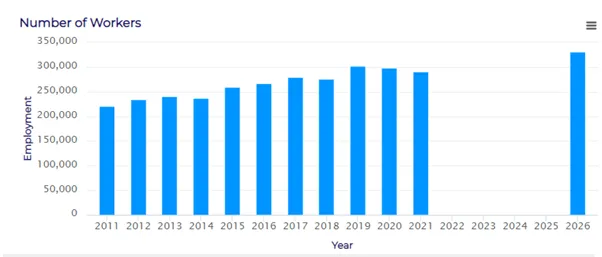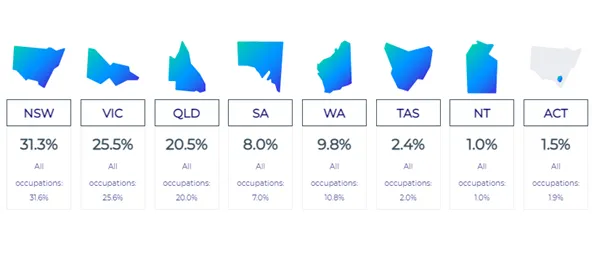Career Growth

Growing Employment and Further Education Outcomes
for Registered Nurses
As a provider of career-focused education for the Nursing sector, IHM places great importance on developing the skills and capabilities of students. As Registered Nurses work is a skills-based profession, and simulations are an integral part of the program and provide a substantial opportunity for students and potential employers to assess employment opportunities and pathways for IHM students. These placement partners are an essential conduit for IHM to remain up to date about industry needs, labour market demand and the training and education requirements to increase the opportunity for successful career transitions for IHNA students.
IHM�s nursing qualifications covers the application of skills and knowledge required to provide nursing care for people across the health sector. Registered nurses (RNs) work for hospitals, medical clinics, residential aged care facilities, and Disability support providers. They may also work for other organizations, such as outpatient facilities, rehabilitation centres, or senior centres. Their main job is to promote patient safety, wellness, and health in a healthcare setting. Other responsibilities are provided below.
- Assessing, planning, implementing, and evaluating nursing care for patients according to accepted nursing practice and standards.
- Working in consultation with other Health Professionals and members of health teams and coordinating the care of patients.
- Providing interventions, treatments, and therapies such as medications, and monitoring responses to treatment and care plan.
- Promoting health and assisting in preventing ill health by participating in health education and other health promotion activities.
- Answering questions and providing information to patients and families about treatment and care; and
- Supervising and coordinating the work of Enrolled Nurses and other health care workers.
Education, training, and experience for Registered Nurses includes a bachelor�s degree in nursing. Alternatively, some people who already have a university qualification, undertake a Master of Nursing (Graduate Entry) degree to obtain registration with AHPRA as a Registered Nurse.
Registration with the Nursing and Midwifery Board of Australia is required.
Registered Nurses – Predicted gap between demand and supply of labour force
The below graph shows the results of the combined scenario and the constrained labour force demand scenario for the acute nursing sector. Using these two scenarios as the basis to examine the relationship between workforce supply and demand, it shows that within five years of the starting point, demand for the acute care nursing workforce exceeds supply, to reach a relatively small workforce gap of approximately 6,400 by 2030.
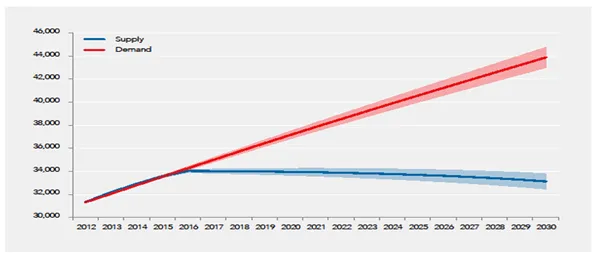
Comparison scenario, registered and enrolled nurses, acute sector, 2012 to 2030
(Reference: Nurses � Australia�s Future Health Workforce reports, 2014)
The below graph shows the comparison scenario for nurses working in aged care. From 2014, demand begins to exceed supply, with the workforce gap extending across the projection period to be approximately 13,000 nurses in 2030 (a 26 per cent gap). The major contributing factors to this result are the ageing workforce and low entry numbers.

Comparison scenario registered and enrolled nurses, aged care sector, 2012 to 2030
(Reference: Nurses � Australia�s Future Health Workforce reports, 2014)
However, it could be observed that the afore mentioned modelling studies done by Health Workforce in 2014 is no where near the expected employment projections for Registered Nurses, in accordance with the recent numbers released by Jobs and Skills Australia (JSA) reports. JSA produces employment projections to show where likely future job opportunities may be. The latest data are for the five years from November 2021 to November 2026. Over this period, the number of workers is expected to grow strongly and is likely to reach 331,200 by 2026. Please see the below graph on employment projections for Registered Nurses.
PayScale for Registered Nurses � Industry Average
An entry-level Registered Nurse (RN) with less than 1 year experience can expect to earn an average total compensation (includes tips, bonus, and overtime pay) of AU$30.86 based on 457 salaries. An early career Registered Nurse (RN) with 1-4 years of experience earns an average total compensation of AU$32.68 based on 2,615 salaries. A mid-career Registered Nurse (RN) with 5-9 years of experience earns an average total compensation of AU$38.64 based on 1,107 salaries. An experienced Registered Nurse (RN) with 10-19 years of experience earns an average total compensation of AU$40.04 based on 625 salaries. In their late career (20 years and higher), employees earn an average total compensation of AU$39.
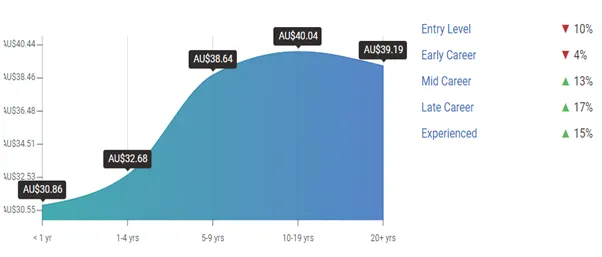
Pay by Experience Level for Registered Nurse (RN)s
(Reference: PayScale: Average Registered Nurse Base Salary Per annum)
Occupational Titles and Popular Career Paths (RN)s for Registered Nurse
The occupational titles for Registered Nurses as per Australian Bureau of Statistics include:
- 254411 Nurse Practitioner
- 254412 Registered Nurse (Aged Care)
- 254413 Registered Nurse (Child and Family Health)
- 254414 Registered Nurse (Community Health)
- 254415 Registered Nurse (Critical Care and Emergency)
- 254416 Registered Nurse (Developmental Disability)
- 254417 Registered Nurse (Disability and Rehabilitation)
- 254418 Registered Nurse (Medical)
- 254421 Registered Nurse (Medical Practice)
- 254422 Registered Nurse (Mental Health)
- 254423 Registered Nurse (Perioperative)
- 254424 Registered Nurse (Surgical)
- 254425 Registered Nurse (Paediatrics)
- 254499 Registered Nurses nec
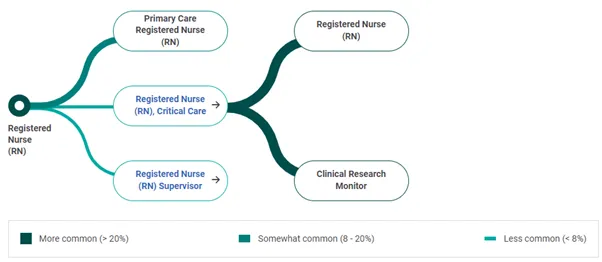
The above table provides information on the most common career paths for Registered Nurses. Thickness and colour of lines indicates popularity of movement from one job to the next.
(Reference: PayScale Report: Popular Career Paths for Registered Nurses)

